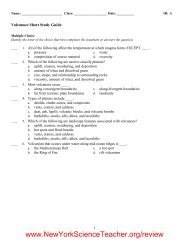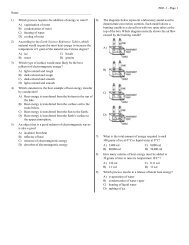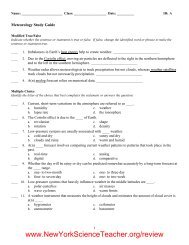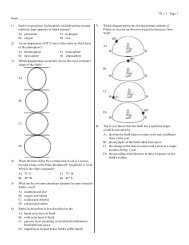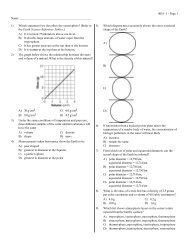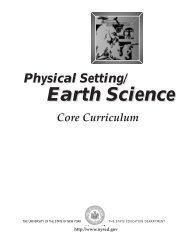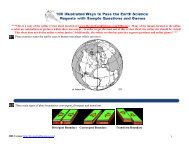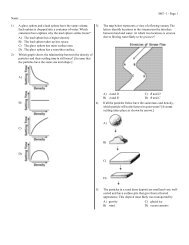pdf - Earth Science Regents Review
pdf - Earth Science Regents Review
pdf - Earth Science Regents Review
Create successful ePaper yourself
Turn your PDF publications into a flip-book with our unique Google optimized e-Paper software.
Name: ________________________ Class: ___________________ Date: __________<br />
ID: A<br />
Glaciers and Mass Movements Study Guide<br />
Modified True/False<br />
Indicate whether the sentence or statement is true or false. If false, change the identified word or phrase to make the<br />
sentence or statement true.<br />
____ 1. After weathering processes take place, mass movements may occur. _________________________<br />
____ 2. A landslide in which layers of snow slide down a mountainside at speeds of up to 300km/hr is a(n)<br />
rockslide. _________________________<br />
____ 3. Because a heavy saturation of water greatly increases the weight of soils, the force of friction is more<br />
likely to pull the material downhill. _________________________<br />
____ 4. The best way to reduce the number of disasters related to mass movements is to relocate people.<br />
_________________________<br />
____ 5. A method of transport by which strong winds cause particles to stay airborne for long distances is<br />
called saltation. _________________________<br />
____ 6. The structure shown in the illustration below is shaped by wind-blown sediments and is called a(n)<br />
ventifact. _________________________<br />
____ 7. Many parts of <strong>Earth</strong>’s surface are covered by thick layers of windblown silt that are called loess.<br />
_________________________<br />
____ 8. When glaciers with embedded rocks move over bedrock valley walls, they grind out perpendicular<br />
grooves and scratches. _________________________<br />
1<br />
www.NewYork<strong>Science</strong>Teacher.org/review
Name: ________________________<br />
ID: A<br />
Multiple Choice<br />
Identify the letter of the choice that best completes the statement or answers the question.<br />
____ 9. Which of the following statements is NOT true about the factors affecting mass movement?<br />
a. Sudden mass movements are usually started by triggers such as earthquakes.<br />
b. After a heavy rain, sediment moves along with the water.<br />
c. A small amount of water may make the slope more stable.<br />
d. An important force that determines a material’s resistance to downhill movement<br />
is friction.<br />
____ 10. Which of the following actions could prevent mass-movement disasters?<br />
a. constructing buildings and roads in stream drainage paths<br />
b. removing trees from steep slopes<br />
c. educating people about the advantages of building on steep slopes<br />
d. digging a series of trenches to divert water around a slope<br />
____ 11. Which of the following statements is true about wind transport?<br />
a. Wind, like water, can only move materials downhill.<br />
b. Wind and water have the same relative ability to erode materials.<br />
c. Wind transport and erosion primarily occur in areas with little vegetative cover.<br />
d. Generally, wind can carry particles as large as those transported by moving water.<br />
____ 12. Dune formation will take place when ____.<br />
a. high winds, sand, and no vegetation are present<br />
b. sand, high winds, and vegetation are present<br />
c. only with quartz sand, high winds, and vegetation are present<br />
d. high winds are available<br />
____ 13. Where there is limited sand available and strong prevailing winds, ____.<br />
a. longitudinal dunes are formed c. no dune formation can take place<br />
b. parabolic dunes form d. transverse dunes are formed<br />
____ 14. Which of the following statements is NOT true about valley glaciers?<br />
a. Flow rates are the same within the various portions of the glacier.<br />
b. The speed of the glacier is affected by the slope of the valley floor.<br />
c. They widen V-shaped stream valleys in U-shaped glacial valleys.<br />
d. Movement is usually less than a few millimeters a day.<br />
____ 15. A ridge consisting of mixed debris deposited by a glacier is a(n) ____.<br />
a. outwash plain c. moraine<br />
b. kettle d. esker<br />
2<br />
www.NewYork<strong>Science</strong>Teacher.org/review
Name: ________________________<br />
ID: A<br />
____ 16. The glacial feature shown below is formed when ____.<br />
a. glaciers pluck a large hole in the valley<br />
b. water from an outwash plain flows into the valley<br />
c. glaciers move over older moraines and form the material into elongated landforms<br />
d. long, winding ridges of layered sediments are deposited by streams flowing under<br />
a melting glacier<br />
____ 17. Which of the following is NOT an indication that creep has occurred?<br />
a. Parallel grooves form in bedrock. c. Trees become bent.<br />
b. Vertical structures become tilted. d. Underground pipelines break.<br />
____ 18. Slumps are common after a rainfall because the water ____.<br />
a. reduces friction between soil grains c. causes snow to melt<br />
b. breaks the underlying rock d. washes away the vegetation cover<br />
____ 19. Which of the following causes deflation?<br />
a. glacial erosion c. wind deposition<br />
b. deposition by meltwaters d. wind erosion<br />
____ 20. Glaciers covered 30 percent of the earth during the last ice age that began about ____.<br />
a. 10 000 years ago c. 2000 years ago<br />
b. 1.6 million years ago d. 50 million years ago<br />
____ 21. Which of the following is NOT true about glaciers?<br />
a. Glaciers can form along the equator. c. Only valley glaciers flow.<br />
b. Glaciers carve U-shaped valleys. d. Glaciers produce moraines.<br />
____ 22. When two cirques on opposite sides of a valley meet, they form a(n) ____.<br />
a. arête c. moraine<br />
b. drumlin d. avalanche<br />
3<br />
www.NewYork<strong>Science</strong>Teacher.org/review
Name: ________________________<br />
ID: A<br />
____ 23. A landslide that occurs on steep slopes in mountainous area is called a(n) ____.<br />
a. rockslide c. avalanche<br />
b. slump d. mudflow<br />
Completion<br />
Complete each sentence or statement.<br />
24. The slow, steady, downhill flow of loose, weathered earth materials is called<br />
____________________.<br />
25. Rocks that are shaped by windblown sediment are known as ____________________.<br />
26. Streams flowing under a melting glacier deposit long, winding ridges of layered sediments called<br />
____________________.<br />
27. The lowering of the land surface that results from the wind’s removal of surface particles is known<br />
as ____________________.<br />
Matching<br />
Match each item with the correct description below.<br />
a. slump d. mudflow<br />
b. creep e. landslide<br />
c. water<br />
____ 28. The slow, steady, downhill flow of loose, weathered earth materials<br />
____ 29. Swiftly moving mixture of mud and water that causes many deaths<br />
____ 30. A rapid, downslope slide of earth materials<br />
____ 31. A landslide in which the material rotates and slides along a curved surface<br />
____ 32. This acts as a lubricant between grains of soils and sediments<br />
Match each item with the correct statement below so that you have arranged the steps of the<br />
formation of a glacier in order.<br />
a. Step 1 c. Step 3<br />
b. Step 2 d. Step 4<br />
____ 33. The weight of the snow exerts extensive downward pressure.<br />
____ 34. Cold temperatures keep fallen snow from completely melting.<br />
____ 35. The snow recrystallizes to form ice.<br />
____ 36. Snow accumulates in an area called a snowfield.<br />
4<br />
www.NewYork<strong>Science</strong>Teacher.org/review
Name: ________________________<br />
ID: A<br />
Match each item with the correct statement below.<br />
a. continental glacier f. mass movement<br />
b. outwash plain g. loess<br />
c. valley glacier h. abrasion<br />
d. cirque i. mudflow<br />
e. drumlin j. slump<br />
____ 37. A mass of ice that forms in mountainous areas<br />
____ 38. A downslope movement of loose sediment and rock under gravity<br />
____ 39. A broad, continent-sized mass of ice<br />
____ 40. Windblown deposits composed of silt<br />
____ 41. A deep depression carved out by an alpine glacier<br />
____ 42. Occurs when sand particles rub against the surface of rocks<br />
____ 43. Where meltwater flows and deposits<br />
____ 44. Swiftly moving mixture of mud and water sometimes triggered by an earthquake<br />
____ 45. A landslide in which earth material rotates and slides along a curved surface<br />
____ 46. An elongated landform produced when glaciers move over older moraines<br />
Short Answer<br />
47. Explain the importance of gravity in all mass movements.<br />
48. What is deflation, and why is it a major problem in agricultural areas?<br />
49. Why is dune vegetation important and what is the danger of removing it from a beach?<br />
50. Compare and contrast the conditions that produce a valley glacier with those that produce continental<br />
glaciers.<br />
51. Describe some of the erosional effects of a glacier found in the mountains.<br />
52. Name and describe the four main classifications of mass movements.<br />
53. What are eskers and how do they form?<br />
54. Explain how and where valley glaciers form. Why do they move?<br />
55. Explain how water can both limit and increase a material’s potential for movement on a slope.<br />
56. Compare and contrast erosion by wind and by glaciers.<br />
57. Identify the landforms shown in the diagrams below. Then compare and contrast them.<br />
5<br />
www.NewYork<strong>Science</strong>Teacher.org/review
Name: ________________________<br />
ID: A<br />
58. A family has decided to build their dream house on a dune on the shore of Lake Michigan. Their<br />
plans call for the natural vegetation to be dug up and construction begun. What are some possible<br />
consequences of their actions? What would you do differently to minimize these consequences?<br />
59. “People impact mass movement just as mass movement impacts people.” Do you agree or disagree<br />
with this statement? Explain your answer.<br />
6<br />
www.NewYork<strong>Science</strong>Teacher.org/review
Name: ________________________<br />
ID: A<br />
Problem<br />
Glaciers are similar to great rivers of ice. Glaciers certainly move slower, but they experience<br />
changes in flow rate much like rivers do. In order to determine a glacier’s flow rate, measurements<br />
are taken by a variety of methods. Some include the measurement of the movement of stakes placed<br />
in the ice, while other methods might include the observation of crevasses in the ice.<br />
The table below contains measurements taken over 5 years. Two measurements were taken each<br />
year, one in April and the other in October. Measurements 1–3 are from the top of the glacier.<br />
Measurements 4–6 are from the bottom of the glacier. The numbers, in millimeters, represent the<br />
movement since the last measurement. Positive numbers mean the glacier is advancing. Negative<br />
numbers mean the glacier is retreating.<br />
Top of Glacier<br />
Bottom of Glacier<br />
Point 1 Point 2 Point 3 Point 4 Point 5 Point 6<br />
Year 1 April 141 164 139 132 147 130<br />
October –8 –22 –7 –12 –18 –13<br />
Year 2 April 163 173 162 139 156 138<br />
October 8 11 7 3 5 2<br />
Year 3 April –2 –3 –1 –14 –15 –15<br />
October –34 –46 –31 –55 –59 –54<br />
Year 4 April 0 –5 –1 –3 –6 –3<br />
October –14 –19 –13 –32 –49 –31<br />
Year 5 April 80 106 78 68 92 68<br />
October 2 7 3 1 4 1<br />
7<br />
www.NewYork<strong>Science</strong>Teacher.org/review
Name: ________________________<br />
ID: A<br />
60. What general statement can you make about the movement of the top of the glacier relative to that at<br />
the bottom of the glacier? Explain why this might happen.<br />
61. Make a general statement about the movement of the glacier over the 5 years of measurements.<br />
Explain your results.<br />
62. Why might scientists wish to measure and track the movement of a glacier?<br />
8<br />
www.NewYork<strong>Science</strong>Teacher.org/review
ID: A<br />
Glaciers and Mass Movements Study Guide<br />
Answer Section<br />
MODIFIED TRUE/FALSE<br />
1. T<br />
2. F, avalanche<br />
3. F, gravity<br />
4. F, educate<br />
5. F, suspension<br />
6. T<br />
7. T<br />
8. F, parallel<br />
MULTIPLE CHOICE<br />
9. B<br />
10. D<br />
11. C<br />
12. B<br />
13. A<br />
14. A<br />
15. C<br />
16. C<br />
17. A<br />
18. A<br />
19. D<br />
20. B<br />
21. C<br />
22. A<br />
23. C<br />
COMPLETION<br />
24. creep<br />
25. ventifacts<br />
26. eskers<br />
27. deflation<br />
MATCHING<br />
28. B<br />
29. D<br />
1<br />
www.NewYork<strong>Science</strong>Teacher.org/review
ID: A<br />
30. E<br />
31. A<br />
32. C<br />
33. C<br />
34. A<br />
35. D<br />
36. B<br />
37. C<br />
38. F<br />
39. A<br />
40. G<br />
41. D<br />
42. H<br />
43. B<br />
44. I<br />
45. J<br />
46. E<br />
SHORT ANSWER<br />
47. All mass movement occurs on slopes. Without gravity, the material would remain in place and not<br />
move.<br />
48. Deflation is the lowering of the land surfaces that results from the wind’s removal of surface<br />
particles. It is a major problem in agricultural areas because the fertile topsoil is removed.<br />
49. Dune vegetation helps to anchor coastal dunes, and removing the vegetation may disrupt and damage<br />
dune growth, which would cause increased beach erosion.<br />
50. Valley glaciers are formed in high, mountainous areas and flow downslope like a thick liquid.<br />
Continental glaciers are formed under the same climatic conditions as valley glaciers, but continental<br />
glaciers are thickest in the center, which forces the rest of the glacier to flatten out in all directions.<br />
51. Pieces of rock are removed through a process called plucking. Valley glaciers widen V-shaped<br />
stream valleys into U-shaped glacial valleys. Glaciers carve deep depressions in the side of<br />
mountains called cirques. Where two cirques on opposite sides of a valley meet, they form an arête.<br />
With glaciers on three or more sides of a mountaintop, a steep peak called a horn is formed.<br />
52. Creep is the slow, steady downhill flow of loose, weathered earth materials. Flows are the slow to<br />
rapid flow of earth materials like thick liquids. Slides are a rapid downslope movement of earth<br />
material. Falls are downhill movements of loose rock at high elevations, in steep road cuts, and on<br />
rocky shorelines.<br />
53. Eskers are winding ridges of layered sediment. They are deposited by streams flowing under glaciers<br />
that are melting.<br />
54. Valley glaciers form in mountainous areas when accumulated snow packs down to recrystallize into<br />
ice. This ice becomes too heavy to maintain its rigid shape and begins to flow like a heavy liquid.<br />
2<br />
www.NewYork<strong>Science</strong>Teacher.org/review
ID: A<br />
55. Too little water may prevent sediment grains from holding together, thus increasing the material’s<br />
potential for movement. Too much water can increase the weight of soils and sediments, thus<br />
making them unstable and increasing their potential for movement. Water can also act as a lubricant<br />
between grains, reducing friction and increasing movement downhill. In contrast, a small amount of<br />
water can help hold the soil particles together, making them more stable and thus inhibiting the<br />
movement downslope.<br />
56. Both wind and glaciers pick up and carry loose sediment. Wind transports sediment by rolling<br />
motion, suspension, and saltation and erodes rocks by abrasion. Wind erosion results in deflation<br />
blowouts and ventifacts. Like wind, glaciers also erode by abrasion, as well as by plucking. Glacial<br />
erosion results in striations, grooves, cirques, arêtes, and horns.<br />
57. A shows a barchan dune, and B shows a transverse dune. Both are piles of sand deposited by wind.<br />
Barchan dunes are crescent-shaped dunes that form in flat areas where there is little sand or<br />
vegetation. Transverse dunes form in a series of long ridges perpendicular to the wind direction<br />
where there is plenty of sand, little or no vegetation, and strong, steady winds.<br />
58. Dunes grow and migrate. This natural dune growth would be disrupted. After construction is<br />
completed, dune migration could bury and block off the structures and property. Also, dune<br />
vegetation helps anchor the sand. Removing the sand may increase beach erosion, and the area may<br />
suffer nearshore flooding. To minimize these consequences, one should disturb the dunes as little as<br />
possible and dig up as little vegetation as possible.<br />
59. Students should recognize the truth in this statement. People do impact mass movement because<br />
their activities can contribute to factors that cause mass movement. Construction can make slopes<br />
unstable. Septic leaks can trigger slides, and excessive logging can promote mass movement. Mass<br />
movement also impacts people in several ways. It can cause damage to property. Villages can be<br />
buried, and homes and forests can be destroyed. Mass movement can also result in loss of lives.<br />
PROBLEM<br />
60. The bottom of the glacier moves slower than the top of the glacier. Friction occurs on the bottom of<br />
the glacier where it comes in contact with the ground. This friction slows down the ice.<br />
61. The glacier does not move in a uniform manner from year to year. In some years, there is no<br />
movement or a retreat, while in other years there is an advance. The advance or retreat of a glacier is<br />
highly dependent upon the amount of snowfall and temperatures during the winter and the summer,<br />
and this varies from year to year, making the movement of this glacier unpredictable.<br />
62. Scientists measure glacial movements as indicators of climate change. Advancing glaciers may also<br />
pose a threat to property downslope.<br />
3<br />
www.NewYork<strong>Science</strong>Teacher.org/review



